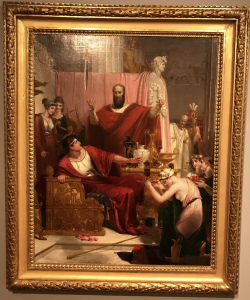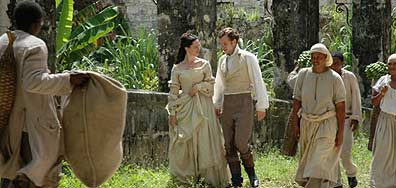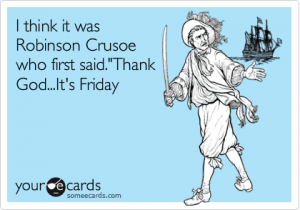The Sword of Damocles was painted by a English artist Richard Westall in 1812. According to the story told by Cicero, Damocles was a man in court that lusted over the kings life and showered him with compliments and flattery. However, the king had a tyrannical reputation and didn’t have many friends, so he lived in constant fear. He decided to invite Damocles to be in his shoes and live the life he lived to teach him a lesson of sorts. Damocles sat on the kings golden chair, ate his food, and wore his clothes. Just as he was starting to really enjoy it all, he noticed a sword hanging directly above his head, only supported by a tiny thin horsehair. The king had put it there to reveal to Damocles that living his life was not so pleasent when your life is constantly under threat, as the sword represented.
There are a couple important ways that Westall represented the story of Damocles accurately in the painting. First, the way that Damocles is positioned. There are many indicators that this picture represents the first time Damocles has seen that sword hanging from the ceiling. His eyes are seemingly staring up at the sword itself and yet we cannot see what his receptive actions are, because he is frozen in his fear. The servant girls are offering him wine to his outstretched hands that are now unmoving. But the jolt of seeing the sword has literally knocked his wreath of his head onto the floor, and he grips the side of the golden chair in fear. I wonder if perhaps his lack of posture was not present before he saw the sword, and when he did, his height gave way. It is no wonder he did, because if one did not know that story and just saw the picture, it would look like the sword was on it’s way to annihilate him.
The second way Westall pictures the story well is through the king, Dionysius. According to history.com, Dionysius is a very unhappy man, and rules with an iron fist. This trait reflects well in the picture, because Dionysius looks very intense. What I found interesting upon first reflection of the image is that because the line of horsehair is so faint, and the king’s hand is raised, it looks like he is magically holding it up with Harry-Potter powers. However, in the story he was the one to hang the sword above Damocles, so perhaps this was Westall’s way of attaching Damocles’ actions to his painted character.
The last way this painting will be analyzed is through the use of color. If one was to squint his eyes and look at the painting, he would see mostly red and white, with any other colors receding into the background. Red is particularly known to be associated with war, danger, or love. Additionally, red is a theme among Westall’s pictures. This theme may have had something to do with the time period, as 1812 was during the french revolution, as well as the beginning of the war of 1812. Obviously, Westall knew what he was doing when we created this masterpiece.



